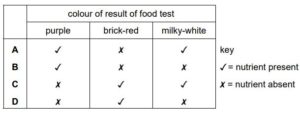Question
Four foods were tested for each of these nutrients:
fat (using the ethanol emulsion test)
protein (using the biuret test)
reducing sugar (using Benedict’s solution).
Which food contains protein and fat?

▶️Answer/Explanation
A
Determination of food containing both protein and fat based on the color results of the food tests is as follows:
For the ethanol emulsion test (fat test): A milky white emulsion indicates the presence of fat.
– For the biuret test (protein test): A purple color indicates the presence of protein.
– For Benedict’s solution test (reducing sugar test): A brick-red precipitate or color change indicates the presence of reducing sugars.
Based on this information, if a food sample shows a milky white emulsion (indicating the presence of fat) and a purple color (indicating the presence of protein), it would contain both protein and fat.
Question
The diagram shows the effect of an enzyme working in the human digestive system.

What would reduce the rate of production of amino acids?
A removing the amino acids as they are formed
B increasing the amount of protein
C raising the temperature to 37.1 °C
D raising the pH to 7.5
▶️Answer/Explanation
D
The correct answer is D: raising the pH to 7.5.
Amino acids are typically synthesized through biochemical reactions in the body, and these reactions are influenced by the prevailing pH conditions. Different enzymes and metabolic pathways responsible for amino acid production have specific pH optima at which they function most efficiently.
Raising the pH to 7.5 would create a more alkaline environment. This altered pH level could disrupt the optimal conditions for the enzymes and pathways involved in amino acid synthesis, thereby reducing the rate of amino acid production. Therefore, increasing the pH to 7.5 would likely decrease the rate of amino acid production.
Question
Four solutions were tested to see whether they contained protein, starch or glucose.
The colours of the solutions after the tests are recorded in the table.
Which solution contained protein and glucose but not starch?
| biuret test | iodine test | Benedict’s test | |
| A | blue | brown | orange |
| B | blue | blue-black | blue |
| C | purple | brown | orange |
| D | purple | blue-black | blue |
▶️Answer/Explanation
C
The results of each test to determine which solution contained protein and glucose but not starch.
1. Biuret test: The biuret test is used to detect the presence of proteins. In this test, Solution A and Solution B both turned blue, indicating the presence of protein. Solution C and Solution D turned purple, suggesting the absence of protein.
2. Iodine test: The iodine test is used to detect the presence of starch. Solution A turned brown, which indicates the presence of starch. Solution B turned blue-black, suggesting the presence of starch. Solution C turned brown, indicating the presence of starch. Solution D turned blue-black, suggesting the presence of starch.
3. Benedict’s test: The Benedict’s test is used to detect the presence of reducing sugars, such as glucose. Solution A turned orange, indicating the presence of a reducing sugar (glucose). Solution B turned blue, suggesting the absence of reducing sugar. Solution C turned orange, indicating the presence of a reducing sugar (glucose). Solution D turned blue, suggesting the absence of a reducing sugar.
Based on the results of the tests, the solution that contained protein and glucose but not starch is Solution C. It turned purple (indicating protein presence) in the biuret test, brown (indicating starch presence) in the iodine test, and orange (indicating glucose presence) in the Benedict’s test.
Question
Small molecules are used as the basic units in the synthesis of large food molecules.
Which statement is correct?
A Amino acids are basic units of carbohydrates.
B Fatty acids are basic units of glycogen.
C Glycerol is a basic unit of oils.
D Simple sugar is a basic unit of protein.
▶️Answer/Explanation
C
Among the options given, the correct statement is: C i.e. Glycerol is a basic unit of oils.
Glycerol, also known as glycerin or glycerine, is a small molecule that serves as the basic unit in the synthesis of oils. It combines with fatty acids to form triglycerides, which are the main components of dietary fats and oils. Triglycerides consist of three fatty acid molecules attached to a glycerol backbone. So, glycerol is an essential component in the formation of oils.
Question
Which identifies the chemical elements found in proteins?

▶️Answer/Explanation
A
The chemical elements carbon, hydrogen, oxygen, and nitrogen are found in proteins. Proteins are composed of long chains of amino acids, and these four elements make up the fundamental components of amino acids. Carbon provides the backbone of the molecule, hydrogen and oxygen are involved in various functional groups, and nitrogen is a crucial element present in the amino group (-NH2) of amino acids. Additionally, proteins may also contain other elements such as sulfur and phosphorus, but carbon, hydrogen, oxygen, and nitrogen are the primary elements found in proteins.
